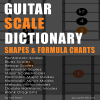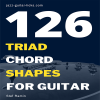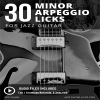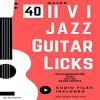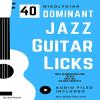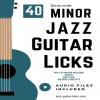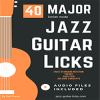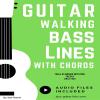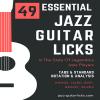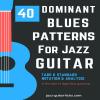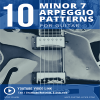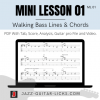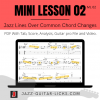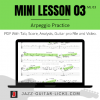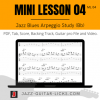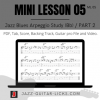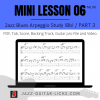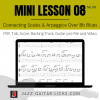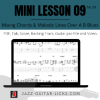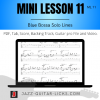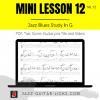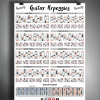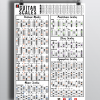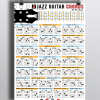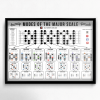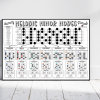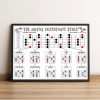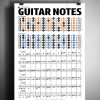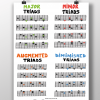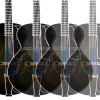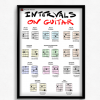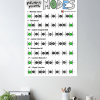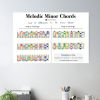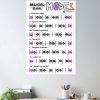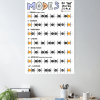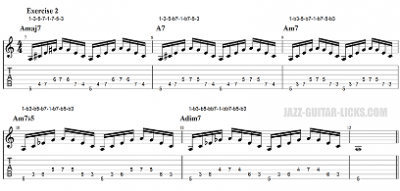
Guitar Practice Routine - 10 Essential Tips
- By jazz-guitar-licks
- On 2024-03-01
- In Guitar Practice Tips
- 2 comments
Learning jazz guitar requires a systematic and disciplined practice routine.
Here's a comprehensive practice plan bringing together 10 essential points to help you develop your jazz guitar skills.
1. Warm-up
Warm-up exercises are essential for guitarists to enhance finger flexibility, improve dexterity, and prevent injuries.
Whether you're a beginner or an experienced player, dedicating a few minutes to warming up can significantly impact your overall playing ability.
Scale Exercises:
- Major Scales: Play major scales in various positions on the neck.
- Minor Scales: Work on natural, harmonic, and melodic minor scales.
- Modal Scales: Explore modes such as Dorian, Mixolydian, and Lydian.
Finger Independence:
- Chromatic Exercises: Play chromatic runs to improve finger independence.
- Spider Exercises: Work on spider-like finger movements to enhance agility.
Arpeggios
- Practice all types of arpeggios anywhere on the guitar neck.
2. Chord Voicings
Chord voicings are the artistic choices we make in arranging and playing chords.
They go beyond the basic open chords, allowing guitarists to explore a rich palette of sounds and textures.
Chord voicings involve selecting specific fingerings and positions on the fretboard, creating diverse tonal variations even when playing the same chord.
Drop Voicings:
- Practice drop 2, drop 3, and drop 2 & 4 voicings for major, minor, and dominant chords.
- Apply these voicings to a ii-V-I progression in multiple keys or to other essential chord progressions.
Extended Chords
- Learn and practice 9th, 11th, and 13th chord voicings.
- Apply these extended chords to jazz standards.
3. Jazz Standards
Exploring jazz standards is akin to delving into a rich musical tradition where improvisation, innovation, and interpretation flourish.
Each standard tells a unique story, offering a framework for musicians to weave their narratives through harmonic exploration, rhythmic ingenuity and melodic expression.
Melody Playing:
- Choose a standard like "Autumn Leaves" or "Blue Bossa" and learn the melody by ear.
- Experiment with different phrasing and articulation.
Comping Patterns:
- Develop comping patterns using the chord voicings learned earlier.
- Play through the standard's chord progressions, emphasizing different chord tones.
Rhythmic Variation:
- Experiment with rhythmic variations while comping to enhance your sense of groove.
- Use a metronome to practice keeping steady time.
4. Improvisation
Improvisation is the art of spontaneous musical expression, a captivating journey where musicians create on the spot, weaving melodies, rhythms, and emotions in real-time.
Mastering the art of improvisation involves understanding scales, chords, and the unique characteristics of your instrument.
It's a dynamic process that encourages creativity and self-expression.
Transcription:
- Start by transcribing short phrases from jazz guitarists you admire.
- Gradually move to transcribing entire solos.
Analysis:
- Break down transcriptions to understand the theory behind the solo.
- Identify scales, arpeggios, and target notes used in the solo.
Application:
- Incorporate transcribed licks and phrases into your own improvisations.
- Experiment with different scales and modes over various chord progressions.

5. Technique and Theory
In the realm of musical proficiency, technique and theory serve as the cornerstones that elevate musicians from mere players to expressive artists.
A balanced approach to technique and theory is essential.
Technique enhances your ability to translate musical ideas into fluid, expressive performances, while theory equips you with the understanding to make informed musical choices.
Technique Exercises:
- Work on specific techniques like legato, alternate picking, slides, hammer-on/off, bends, and string skipping.
- Apply these techniques to jazz patterns and scales.
Theory Application:
- Study chord-scale relationships and practice applying appropriate scales to chords.
- Experiment with different chord substitutions in progressions.
6. Ear Training
Ear training involves honing the ability to recognize intervals, identify chords, and reproduce melodies.
This skill not only sharpens your listening acuity but also transforms the way you approach learning and performing music.
It's about developing a finely tuned musical ear that guides your playing and enriches your musical expression.
Interval Recognition:
- Use an app or a website to practice recognizing intervals by ear.
- Apply this skill to recognize intervals within jazz chords and melodies.
Chord Recognition:
- Train your ear to identify different chord qualities (maj7, min7, dom7, dim7, etc) in isolation and within progressions.

7. Rhythm
Understanding and internalizing rhythm involves more than just counting beats—it's about feeling the groove, creating dynamic accents, and maintaining a steady pulse.
Rhythm mastery empowers you to infuse your playing with energy, emotion, and a sense of musicality.
Rhythmic Patterns:
- Practice various strumming patterns and rhythmic comping.
- Use a metronome or drum tracks to develop a strong sense of timing.
Syncopation:
- Explore syncopated rhythms and accents in your comping and chord playing.
8. Repertoire Expansion
Just as a chef constantly discovers new ingredients to create diverse and flavorful dishes, musicians expand their repertoire to enrich their musical palette.
Repertoire expansion is the process of broadening the collection of songs and pieces a musician can perform, ensuring versatility and the ability to adapt to various musical contexts.
Learn New Standards:
- Regularly add new jazz standards to your repertoire.
- Experiment with different keys and arrangements.
Chord Substitutions:
- Explore advanced chord substitutions for common progressions.
- Learn to apply tritone substitutions and diminished chords.

9. Recording and Self-Evaluation
The process of recording not only documents your playing but also unveils nuances that may go unnoticed in real-time.
It's a powerful means to analyze your technique, explore your tone, and showcase your musical ideas.
Self-evaluation, then, becomes a critical skill in understanding your playing style, identifying areas for improvement, and celebrating your accomplishments.
Recording:
- Record yourself regularly to track your progress.
- Focus on clarity, timing, and expression in your recordings.
Evaluation:
- Listen critically to your recordings and identify areas for improvement.
- Use the feedback to set goals for future practice sessions.
10. Relaxation and Enjoyment
Finding a balance between disciplined practice and sheer enjoyment is essential.
Relaxation allows you to play with ease, fostering a natural flow in your movements and promoting a more expressive and authentic playing style.
Enjoyment, on the other hand, is the fuel that keeps your passion alive, reminding you why you picked up the guitar in the first place.
Free Play:
- Spend a few minutes playing something you genuinely enjoy.
- Experiment with different styles or improvise freely.
Reflect:
- Reflect on your practice session and acknowledge your achievements.
- Set positive intentions for your next practice session.
Remember, consistency is key. Adjust the time allocated to each section based on your preferences and available time.
As you progress, you can also introduce more advanced concepts into your routine.
-
Guitar Chord Dictionary
This PDF eBook provides over 550 guitar chord shapes. This is the perfect reference guide to understand how chords are built and how to play them on the guitar neck. -
Guitar Scale Dictionary
This E-book is a printable PDF method including over 700 scale diagrams and formula charts for guitarists. -
Harmonized Scales For Guitar
Complete guitar PDF on harmonized scales: major, minor, harmonic and melodic. Includes chord and arpeggio diagrams, charts and practical tabs. -
172 Arpeggio Shapes For Guitar
This printable PDF is a method dedicated to guitarists of all styles who want to learn build and play the most important types of arpeggios. -
126 Triad Chord Shapes
This handbook for guitar players is intended both for teachers and students. It includes 126 guitar shapes for mastering triads. -
Harmonic Major Scale Chords
this PDF offers diagrams and tabs for guitar to learn the chords of the harmonic major scale. -
Major Scale Harmonization
This package provides a printable PDF with exercises and audio files to learn how to harmonize the major scale with 3 note chords and their extensions. -
30 Minor Arpeggio Licks
This package includes a printable PDF method containing 30 exercises with tabs, staves and audio files for practicing minor arpeggios on guitar. -
II V I Bundle - 170 Exercises
This bundle contains 4 PDF methods for a total of 170 exercises with tabs, staves, analysis & audio files for practicing scales, arpeggios licks & chords over the 2-5-1 progression. -
Diatonic Licks Bundle
This package contains 120 jazz guitar lines based on diatonic modes as Mixolydian, Dorian and Ionian. PDF format with tabs, audio files and analysis. -
30 Groovy Jazz Guitar Licks
This downloadable package contains a PDF WITH audio files giving access to 30 groovy guitar phrases mixing jazz, blues and funky licks for beginners. -
30 Smooth Jazz Guitar Licks
In this package you'll get a printable PDF Method with tabs, notation, analysis, scale shapes and audio files for practicing 30 smooth jazz guitar licks. -
40 II V I Jazz Guitar Licks
This pdf method for guitar contains fourteen 2 5 1 jazz guitar lines with tab, standard notation, analysis, scale charts and audio files. -
50 II-V-I voicings
This printable PDF guitar method provides 50 exercises with audio files, analysis, tab and staves for learning major 2-5-1 chord voicings. -
40 Minor 2 5 1 Chord Voicings
This PDF method contains 40 exercices with tabs, scores and audio files for practicing jazz guitar chords over the minor 2 5 1 progression. -
40 Minor II V I Licks
This guitar method is a printable PDF with tabs, diagrams, theory and audio files providing 40 minor 2 5 1 jazz patterns. -
40 Mixolydian Jazz Guitar Lick
PDF guitar method with tabs, audio files and theory providing 40 dominant jazz guitar lines for teachers and students. -
40 Minor Jazz Guitar Licks
This printable guitar method in PDF format contains 40 easy minor jazz guitar lines based on the Dorian mode. -
40 Major Jazz Guitar Licks
Printable PDF eBook method containing 40 major jazz guitar licks with tab, standard notation and audio files for beginners and intermediates. -
Guitar Walking Bass Lines
This jazz guitar method about walking bass lines and chords is available as a PDF files containing 35 exercises with tabs, analysis and audio files -
101 Dominant Arpeggio Patterns
This printable PDF method provides 101 dominant arpeggio exercises with tab, theory and standard notation for the jazz, blues and rock guitarist. -
49 Essential Jazz Lines
This printable eBook method in PDF format provides 49 jazz solo transcriptions of the greatest jazz musicians. Tab, standard notation, audio files & analysis. -
11 Jazz Blues Studies
11 jazz blues chord studies with tabs, standard notation, analysis, and audio recordings and PDF. -
10 Easy Fingerstyle Blues
This PDF with Tabs and audio files provides 10 easy acoustic fingerstyle blues guitar studies for kids and beginners. -
25 Altered Jazz Guitar Lines
This PDF eBook method contains 25 altered jazz guitar licks with tabs, patterns, scale charts and audio files to master, apply and develop the altered scale. -
40 Blues Dominant Patterns
This printable method is available as a PDF file containing 40 easy dominant jazz-blues guitar lines with tabs, standard notation, analysis, audio files and scale charts. -
25 Pentatonic Licks
This jazz guitar method is an eBook available as a PDF with standard notation, guitar tabs, diagrams, analysis, audio files and backing tracks. You will find in this booklet 25 easy jazz guitar lines with theory using common and rare pentatonic scales. -
25 Soul Jazz Guitar Licks
You will find here an eBook available in PDF containing 25 soul jazz and hard bop guitar licks in the style of Grant Green, Melvin Sparks, George Benson. -
25 Diminished Patterns
This eBook PDF with audio files contains 25 dominant diminished jazz guitar patterns using the half-whole diminished scale and diminished 7th arpeggios. -
6 Tritone substitution licks
This Printable PDF eBook available for free download contains 6 easy jazz guitar licks with tabs/notation, youtube video link and analysis about the tritone substitution. -
10 Minor 7 Arpeggio Patterns
This printable PDF eBook offers 10 easy minor 7 arpeggio patterns with its related YouTube video for beginner guitarists. -
10 Easy Major 7 Arpeggio Licks
This is a printable PDF for beginner jazz guitar players providing 10 easy licks to practice major 7 arpeggios. -
10 Chord Melody Lines
Within this package, you'll discover a set of ten chord melody exercises for beginners. Printable PDFaudio files, a backing track, and a link to the associated YouTube video. -
10 Minor Blues Scale Licks
You'll find here a PDF with 10 easy jazz guitar licks to practice the minor blues scale on guitar.
-
Mini Lesson 01 (ML 01)
You'll find a mini guitar lesson about walking bass lines and chords containing a PDF with tab, score analysis, shapes, a video and a guitar pro file. -
Mini Lesson 02 (ML 02)
In this mini jazz guitar lesson you will learn how to play easy and cool jazz lines over basic chord changes found in jazz. Pdf, tab and video included. -
Mini Lesson 03 (ML 03)
With this short lesson you will learn how to play and connect basic guitar arpeggios over a diatonic chord progression. -
Mini Lesson 04 (ML 04)
This is a downloadable package with PDF, Tab, guitar pro file and video to practice guitar arpeggios over a jazz blues chord progression. -
Mini Lesson 05 (ML 05)
This downloadable package provides a PDF with Tab/score, a guitar pro file and a short video for practicing guitar arpeggios on a jazz blues progression in Bb. -
Mini Lesson 06 (ML 06)
This package for guitarists contains a PDF with tab, video, backing track and guitar pro file for practicing arpeggios over a basic jazz blues progression. -
Mini Lesson 07 (ML 07)
With this mini guitar lesson you will learn how to superimpose arpeggios over a diatonic chord progression. Video, pdf, jamtrack and guitar pro file included. -
Mini Lesson 08 (ML08)
Mini lesson with PDF, guitar pro file, video and backing track for practicing scale and arpeggio connections over a Bb jazz blues progression. -
Mini Lesson 09 (ML09)
This mini lesson is a downloadable package containing a PDF, video, backing track and guitar pro file of a jazz blues progression study in B. -
Mini Lesson 10 (ML 10)
This mini guitar lesson provides a printable PDF with tab/notation, video, backing track and guitar pro file for practicing open triads over Fly Me To The Moon. -
Mini Lesson 11 (ML 11)
This guitar lesson is a package inlcuding a PDF transcription with analysis, a short video, a backing track and a guitar pro file to learn to play jazz solo lines over Blue Bossa. -
Jazz Blues Guitar Study (ML12)
This mini lesson provides a video, a guitar pro file and PDF transcription of a jazz blues study in G implying melodic lines, chord extensions and substitutions
-
Guitar Arpeggios Poster
This giant guitar poster for any guitar player, student or instructor contains colorful arpeggio diagrams. Giant size 24 x 36 inches (60 x 90 cm). -
Guitar Scales Poster 24*36
Guitar posters and wall art with eighteen neck diagrams representing the most used scales in music. -
Guitar Chord Poster
This printed color posters contains 63 guitar chord diagrams for jazz players, students, teachers and schools. -
Guitar Modes Poster
Guitar reference posters and wall art about modes of the major scale for guitar teachers, students and music schools. -
Melodic Minor Modes Poster
Educative and decorative giant guitar poster with neck diagrams, interval names about the seven modes of the melodic minor scale. -
Pentatonic Scale Guitar Poster
This guitar reference poster shows the positions and intervals of the major pentatonic scale. -
Guitar Notes Poster
This is a giant poster showing the notes on the guitar fret board and their positions on a musical staff. -
Triads Guitar Poster
This reference poster show the positions and intervals of the main triads used on guitar. This is a useful tool for guitarists, teacher and students. -
Four Archtop Guitars Poster
This is a decorative poster with four archtop jazz guitars. Several size and colors in landscape format available on Teespring and redbubble. -
Intervals On Guitar - Poster
This giant poster for guitar provides neck diagrams with interval positions. -
Melodic Minor Modes
This music theory poster available in several sizes shows the construction of the seven modes of the melodic minor scale. -
Major Scale Chords
This handy poster provides a clear visual guide to the chords built from the major scale, helping you recognize patterns and improve your playing. -
Melodic Minor Chords
Explore the rich harmonic possibilities of the melodic minor scale with this essential guitar poster. -
Harmonic Minor Modes
This music theory poster, offered in various sizes, demonstrates the structure of the seven modes of the melodic minor scale. -
Harmonic Minor Chords
Discover the chords of the harmonic minor scale with this guitar poster. -
Major Scale Modes
This poster is created for music teachers and students, illustrating the structure of the seven modes of the major scale.
guitar practice MusicTips GuitarTechnique Standards EarTraining
Comments
-

- 1. Rock Out Loud On 2025-05-09
These tips strike a good balance between structure and flexibility. It's a strong guide for building better habits and keeping motivation up during practice.-
- jazz-guitar-licksOn 2025-05-12
Yes that's it
Add a comment



